01.09.2007: I have finally ordered all the options for the SportCruiser, which are (only the major ones):
- Sensenich propeller
- Wheel fairings
- Leather upholstery
- Dual hydraulic brakes and parking brake
- Dynon glass cockpit (D100 plus D120)
- PM3300 stereo intercom
- TruTrack Digiflight II autopilot
I still haven’t decided on the avionics, but an AvMap IV GPS will probably be the third screen, and an 8.33 kHz radio and a mode-S transponder will go in as well.
I am currently checking the IFR requirements, as an IFR approval is one of the ideas on my wish list. Not that I am planning heavy IMC-weather flying, but IFR would give some more flexibility when traveling and would make the IFR rating affordable. As an alternative Night VFR would be an option too.
I am also looking into ergonomic aspects of panel design. I have seen “horrible” examples, with instruments cluttered everywhere except where they belong. I rather want to design something where all the controls are easily reachable and where one would expect them to be.
My latest version looks as follows:

Compared to the previous example I have moved the radio and the transponder to below the GPS, so that they are easier to reach. I have also moved the backup ASI and Altimeter to below the Dynon and I have left room for a backup Gyro (IFR…). Both moves also allow me to have the three screens at the same height, which is probably easier to scan (and looks better). Also the backup instruments form half a 6-pack so if they have to be used they are easy to scan. Again, this is only a draft and will improve over time. I will also have to consider mechanical restrictions, but for that I need detailed plans or the kit itself.
05.09.2007: I was contacted by Markus Petrak from Germany, who especially liked the kit selection part of my homepage. He asked if he could copy part of it for his own page, as he is currently in the process of selecting a kit to build. Of course I agreed, you can find his very nice page under www.regensturm.de.
I also had a look at panels of high end GA aircraft to refine ours, as I assume that those manufacturers spent at least some time optimizing panel layouts.
Diamond DA40
Below a picture of the panel of a Diamond DA40, equipped with the Garmin 1000.

The right display is not straight in front of the passenger seat, as the arrangement is optimized for single pilot operation. The backup ASI, Gyro and Altimeter are located on top between the two screens, the radios are integrated with the Garmin.
Cirrus SR 22
Below the panel of a Cirrus SR 22, equipped with Avidyne Displays and Garmin 430’s.

The right display is again not straight in front of the passenger seat, probably again optimized for single pilot operation. It is also tilted slightly towards the pilot, which improves readability. The backup ASI, Gyro and Altimeter are located below the left screen, the radios etc in the centre.
Cessna Mustang
And finally the new Cessna Mustang jet, again equipped with the Garmin 1000, plus an additional third screen.

Here the right display is straight in front of the passenger/co-pilot seat, as it is used primarily as a PFD for the copilot. The plane is probably more likely flown with two pilots than by a single pilot. In addition, from a single pilots point, the arrangement is similar to the ones above, as the third screen used for GPS navigation is between the two PFS’s. The backup ASI, Gyro and Altimeter are located on top of the centre screen, probably so that they are visible for both pilots in the case of dual pilot operation.
Cessna SkyCatcher
And finally the new Cessna SkyCatcher, which will probably be the most sold Sportpilot category aircraft within no time.
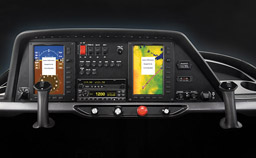
It’s panel consists of a Garmin 300 PFD with an optional second screen. The right display is again not straight in front of the passenger/instructor seat, as it is used for navigation by the pilot. There are no backup ASI, Gyro and Altimeter in the proposed layout, I guess at least an ASI will have to go in even if IFR is not aimed at.
Of course I’m not building a twin engine light jet, or even a high performance single, but it is always interesting to look how the big guys are doing things. My current layout seems to be already quite in line with them. With my three screen solution I can move the second PFD/EMS straight in front of the passenger, which will be an advantage if I ever intend to use the plane for flight training. From the above examples I can also see that the panel colour is typically a dull, dark grey, not the light grey as in my example above, so I might change that.
15.09.2007: Rolf and I are starting to look into the various lights required on our SportCruiser (landing lights, position lights and anti collision lights), as we want to design and build them our self with LED’s. I have added a lighting page to the kitbuilding section.
I had a mail exchange with Chip Erwin from CZAW today, he says delivery in January is guaranteed, but December still possible.
17.09.2007: I received the order confirmation from CZAW today. Everything seems ok except that they ask me to send them the upholstery specs, but I never received any description on what I have to specify. I am however sure that this can be resolved quickly. The only problem will be that I will have to specify the colour, which means I should think about the painting too. I guess that a light colour will be better, as black seats probably just get too hot in the sun.
17.09.2007: I continued looking into the colour questions of the interior. Here some pictures:
a Zodiac CH601XL with white seats,
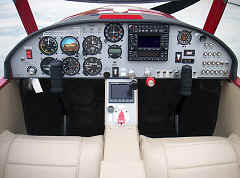
a Beechcraft Baron with light grey seats,

a Lancair IVP with white and grey/blue

and here a Diamond DA50 in light beige.

One can already see that I somehow prefer the light colours.
I also found another nice panel, from the new Diamond DA50, which is nicely in line with the previously shown examples.
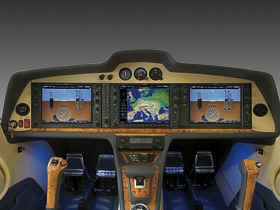
23.09.2007: Yesterday I visited a fellow builder, Urs Spuler, who is building an FK 12 Comet. It is a nice little biplane and a nicely done kit. Urs gave me valuable information on how he transported the kit and got it through customs when he went to pick it up himself in Poland. We are planning to do the same, as the CZAW factory is only about 800 km from where I live.
Today I also started looking into what I have to do to get my workshop ready. I still hope I will get my kit before Christmas, and as I will be working in Australia again from middle of November to shortly before Christmas I have to have the workshop ready before I leave (that’s in 8 weeks!).
The workshop will be in my 6.36 m x 3.28 m garage. That is larger than a normal one car garage, as building a plane was already on the agenda when we built our house (smart, isn’t it?). The garage has never seen a car inside however, as the kids toys, bicycles, lawn mower, gardening tools etc. take up all the space. I will have to find room for all of that somewhere else in the house or an arrangement where plane and “equipment” can coexist.

Below a layout of the garage.
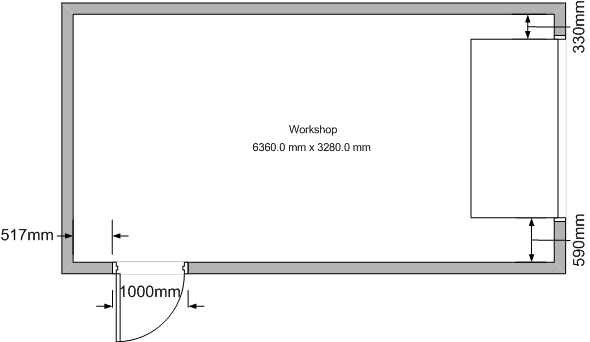
I will see how the SportCruiser fits into it. I have tried below, and it seems to be tight fit. I have already figured out that once the rudder, engine and spinner are all installed I can’t close the door anymore, unless I put the fuselage perpendicular, but by that time the plane should be at the airport anyway. Otherwise there should be enough room.
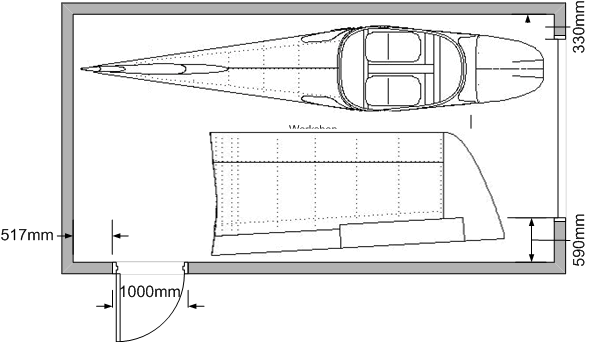
Unfortunately the garage is neither heated nor insulated, so building during the colder periods of the year will be restricted, but I also have a 4 m x 4 m workshop in the cellar which is heated. We will therefore spend more time working on the panel and other such things during that time. We will also use that room for storing all the parts. We might even be able to take the wings into the cellar one by one, but I am not sure yet.
What I will have to add to the garage before we start building is proper lighting, as the single fluorescent tube that is currently in there is not enough.
I also added a section on engine selection to the kit building section, just for information. It might contain some interesting information for the more experimentally minded builder.
28.09.2007: I dived deep into the avionics question again. For the basic instrumentation we have selected the Dynon D-100/D-120 combination, together with the new HS34 extension module. This module provides interfaces between NAV units (GPS, VOR etc.) and the D-100, but also a number of other features like the input of values (air pressure, heading bug, course etc.) via knobs, voice annunciations etc. Dynon just published updated manuals for the D-100/D-120, which include the description of the HS34 features. My first impression: Wow.
The interface to VOR units has been tested with a number of devices from Garmin. The only one of them which is in a price range ordinary human beings can afford is the SL-30. Having a VOR in addition to the GPS would be quite helpful, so if we could achieve this by using the SL-30 NAV/COM instead of an ordinary COM would probably be the optimum from a cost point of view. Together with a Garmin 328 transponder the panel would then look as follows:

The disadvantages of this solution would be that the radio is 25 kHz instead of 8.33 kHz, and of course the price. I can however not find a cheaper possibility to get a VOR.
I have also received the leather colour chart from CZAW, so I can look into that question as well.

29.09.2007: I try not to neglect flying next to all my investigations, so today I took the L4 and went a little sightseeing.
It’s roughly 20 miles from Lommis to the nearest mountains, or what we call mountains here (for my colleagues from northern Germany already the airport lies in the mountains…).
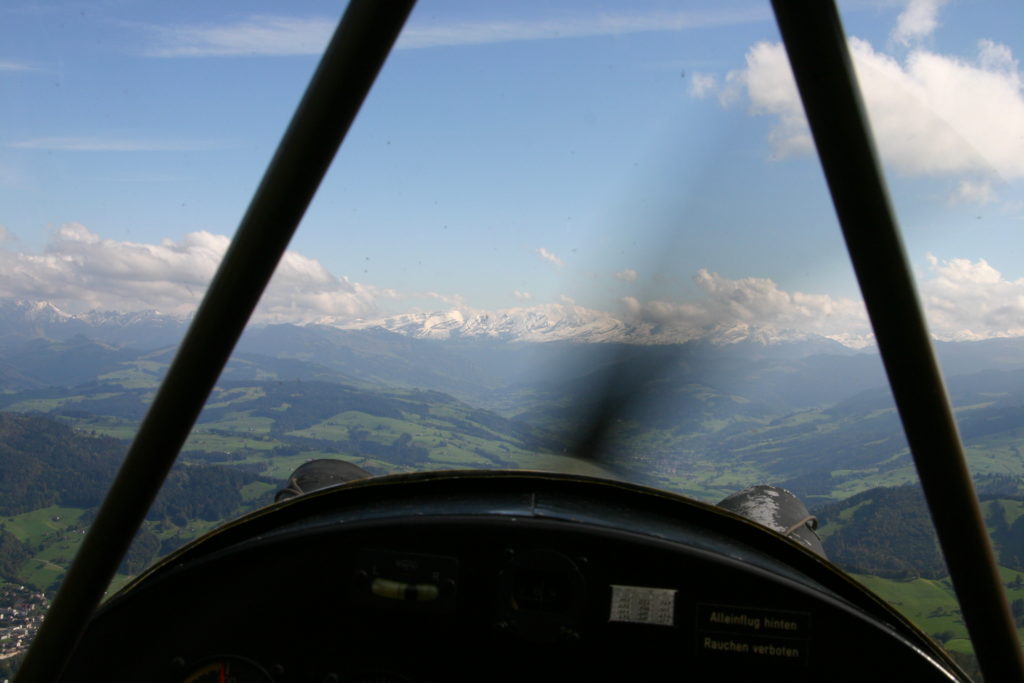
This chain of seven mountains shown below is called Churfirsten, from left to right they are called Chäserugg, Hinterrugg, Schibestoll, Zuestoll, Brisi, Frümsel und Selun. They are all between 2200 and 2300 m high, behind them lies a lake called Walensee at 420 m. The terrain drops nearly vertically on the south side of the chain, quite impressive if you sit on top.
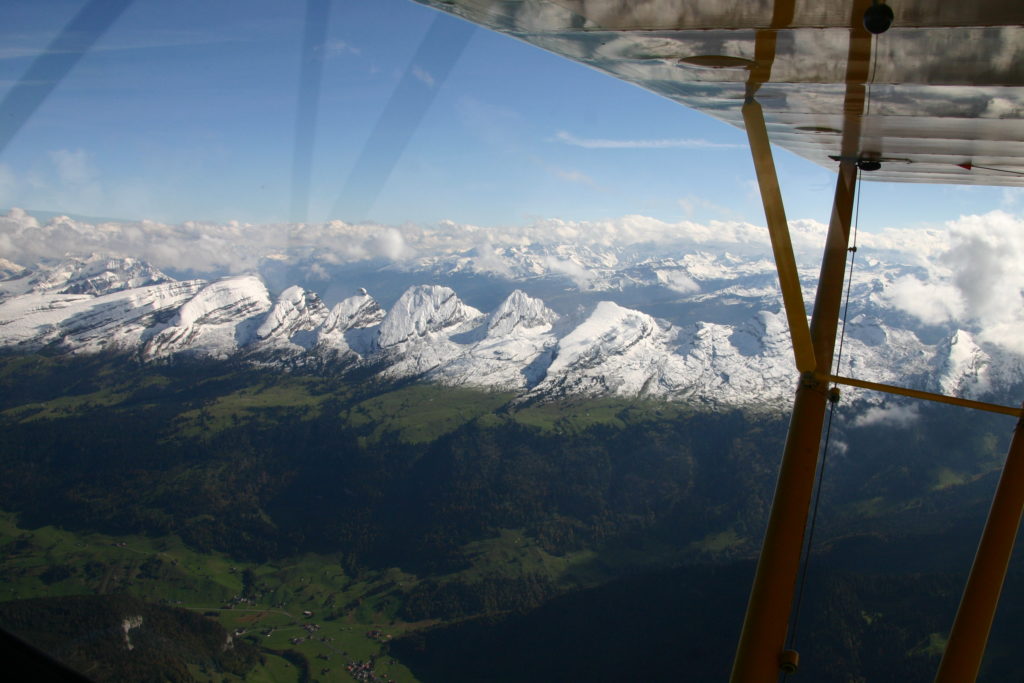
I then turned towards the Säntis, which is with 2501 m the highest peak of that part of the Alps. On top is a 10 storey telecom installation, here visible in the clouds, topped by a 120 m antenna tower. The actual antennas are installed within a fiberglass housing, which is heated to prevent ice build up and can withstand 300 km/h wind (the have had around 250 km/h during a storm some years ago).

Below a picture of the L4 after landing. It is my favourite from out club’s range of planes for doing some sightseeing on a sunny afternoon. If you want to do some travelling it is however not the right plane to use, due to it’s low speed (65 knots cruise), low range (200 miles) and mostly due to the need to find somebody who is willing to start it by hand as it has no electric starter. The 178 kg payload (122 with full fuel) doesn’t really help either.

30.09.2007: I have updated the panel design section to be in line with the current ideas.